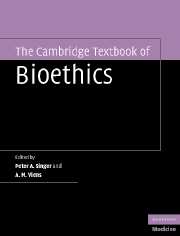Book contents
- Frontmatter
- Contents
- List of contributors
- Acknowledgements
- 1 Introduction
- Section I Information problems
- Section II End of life care
- Section III Pregnant women and children
- Section IV Genetics and biotechnology
- Section V Research ethics
- Section VI Health systems and institutions
- Section VII Using clinical ethics to make an impact in healthcare
- Section VIII Global health ethics
- Section IX Religious and cultural perspectives in bioethics
- Section X Specialty bioethics
- Introduction
- 56 Surgical ethics
- 57 Anesthesiology ethics
- 58 Critical and intensive care ethics
- 59 Emergency and trauma medicine ethics
- 60 Primary care ethics
- 61 Infectious diseases ethics
- 62 Psychiatric ethics
- 63 Neuroethics
- 64 Pharmacy ethics
- 65 Alternative and complementary care ethics
- Index
- References
65 - Alternative and complementary care ethics
Published online by Cambridge University Press: 30 October 2009
- Frontmatter
- Contents
- List of contributors
- Acknowledgements
- 1 Introduction
- Section I Information problems
- Section II End of life care
- Section III Pregnant women and children
- Section IV Genetics and biotechnology
- Section V Research ethics
- Section VI Health systems and institutions
- Section VII Using clinical ethics to make an impact in healthcare
- Section VIII Global health ethics
- Section IX Religious and cultural perspectives in bioethics
- Section X Specialty bioethics
- Introduction
- 56 Surgical ethics
- 57 Anesthesiology ethics
- 58 Critical and intensive care ethics
- 59 Emergency and trauma medicine ethics
- 60 Primary care ethics
- 61 Infectious diseases ethics
- 62 Psychiatric ethics
- 63 Neuroethics
- 64 Pharmacy ethics
- 65 Alternative and complementary care ethics
- Index
- References
Summary
Ms. M, a patient with a rare skin condition who has failed all relevant conventional therapies, asks her dermatologist, Dr. N, about treatment options involving complementary and alternative medical (CAM) therapies. Dr. N mentions a homeopathic remedy commonly available in pharmacies and health food stores; Ms. M tries the remedy, and the skin condition quickly resolves. She is elated by this success and tells her best friend, a neurologist, who promptly files a complaint with the state medical board, noting that few, if any, physicians of any subspecialty in the state ever recommend homeopathy for any condition. The board holds a hearing at which there is no evidence that Dr. N has ever harmed a patient or acted unskillfully or incompetently in any way. Indeed, several dozen patients testify that Dr. N is a skilled, caring healthcare professional. The board nonetheless decides to revoke Dr. N's license based on a state statute defining professional misconduct as “any departure from acceptable and prevailing medical standards.” Subsequently, Ms. M sues Dr. N for malpractice, alleging that he failed to adequately discuss the risks and benefits of a different CAM therapy – acupuncture – for her condition, and, in the alternative, that by inducing her to rely on homeopathy he neglected conventional dermatological treatment.
What are complementary and alternative medical therapies?
Complementary and alternative medical (CAM) therapies refer to those modalities and whole systems of healing that historically have not been part of the dominant system of medical practice in the West.
- Type
- Chapter
- Information
- The Cambridge Textbook of Bioethics , pp. 513 - 520Publisher: Cambridge University PressPrint publication year: 2008
References
- 2
- Cited by



